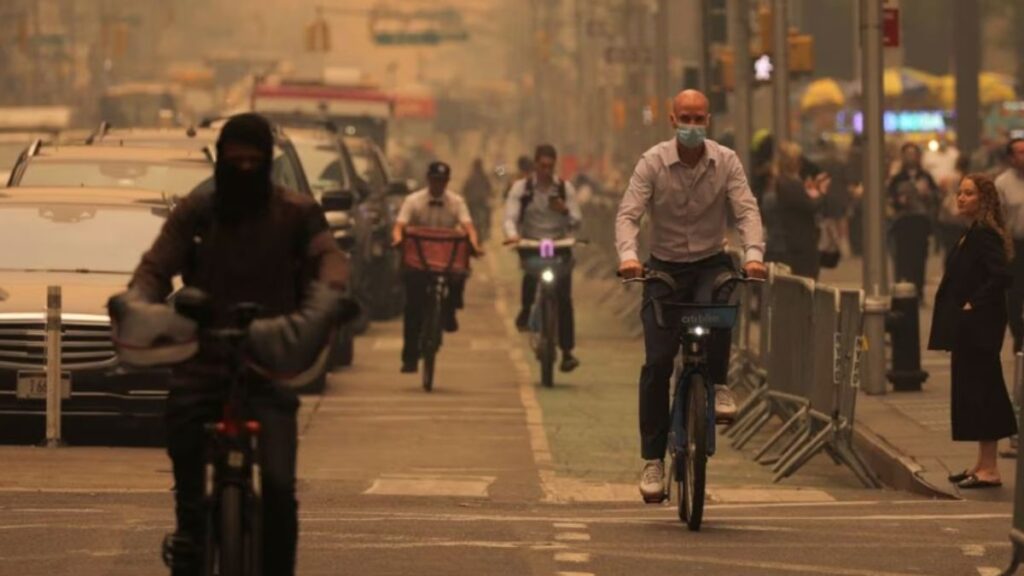
Amidst smoke from Canadian wildfires, a man dons a face mask during a code orange air quality alert
On Sunday, the north-eastern US experienced a resurgence of poor air quality, although it was significantly milder compared to the intense haze that recently enveloped the area and garnered international attention. This haze, caused by smoke carried by the wind from the fierce Canadian wildfires, led to orange skies, thick smog, and remarkably high levels of pollutants
During Sunday morning, a plume of smoke drifted across New York City, resulting in an air quality index of 103, classified as “unhealthy for sensitive groups,” especially individuals with heart or lung conditions
Based on data from the city’s environmental and health data portal, the air quality has shown significant improvement over time since the city was enveloped in a dense yellowish haze last week, caused by smoke from ongoing Canadian wildfires. Unfortunately, there are minimal indications of the fires being extinguished in the near future
Despite overall improvements in air quality, significant variations are still observed on an hourly basis, “even in neighborhoods known for their clean air,” according to the portal. The portal further stated that this implies that certain individuals in New York may be exposed to high levels of pollutants for short durations.
Meanwhile, in Pennsylvania, the state department of environmental protection declared an air quality action day on Sunday and issued a code orange alert. This alert was triggered by elevated ozone levels across three regions in Pennsylvania, including the Philadelphia area, the Lehigh Valley, and the central Pennsylvania counties of Cumberland, Dauphin, Lancaster, Lebanon, and York, as reported by Penn Live
The department highlights that individuals who are particularly at risk due to air pollution include young children, the elderly, and those with respiratory conditions. They are advised to limit their outdoor activities.
Ozone is formed when airborne chemicals like carbon monoxide and nitrogen oxide react with sunlight. High levels of ozone are most prevalent during the summer months, characterized by long sunny days and increased concentrations of airborne chemicals.
In light of the situation, the department encouraged residents on Sunday to adopt energy conservation measures, such as setting air conditioning to higher temperatures, combining errands to reduce vehicle trips, minimizing engine idling, and refueling vehicles after dusk.
Additionally, the Maryland environmental department has issued a code orange alert for Sunday in the Baltimore region
The environmental department stated that the presence of diffuse smoke and a polluted air mass transported from the south, combined with the return of sun and heat, is expected to result in unhealthy air quality for sensitive groups (USG) around and northeast of Baltimore on Sunday.
WBAL-TV meteorologist Dalencia Jenkins mentioned in a tweet that the poor air quality in the Baltimore metro and Annapolis region is not solely attributed to wildfire smoke, but also to the presence of ozone pollutants in the air. Jenkins advised individuals who are sensitive to air pollutants to limit their outdoor activities.
Meanwhile, despite the efforts of firefighters from various countries assisting Canada in combating the wildfires, hundreds of fires are still burning. The Canadian Interagency Forest Fire Centre reported that as of Friday, there were still 421 active fires.






